| Five Races Under One Union | |||||||||
|---|---|---|---|---|---|---|---|---|---|
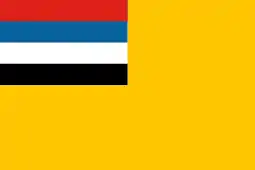 The National Flag of Manchukuo | |||||||||
| Chinese name | |||||||||
| Traditional Chinese | 五族協和 | ||||||||
| Simplified Chinese | 五族协和 | ||||||||
| |||||||||
| Korean name | |||||||||
| Hangul | 오족협화 | ||||||||
| Hanja | 五族協和 | ||||||||
| |||||||||
| Japanese name | |||||||||
| Kanji | 五族協和 | ||||||||
| Hiragana | ごぞくきょうわ | ||||||||
| |||||||||
Five Races Under One Union (Chinese: 五族協和, Japanese: 五族協和) was used as a national motto in Manchukuo, for the five ethnic groups of the Manchus, the Japanese, the Han Chinese, the Mongols and the Koreans. It was similar to the "Five Races Under One Union" (Chinese: 五族共和) motto used by the Republic of China, for the Han, Manchus, Hui, Mongols and Tibetans, but the third of the four Chinese characters was changed from Togetherness (共) to Cooperation (協). Both mottoes were pronounced the same "Go zoku kyōwa" in Japanese.
This motto was symbolized in the national flag of Manchukuo, as the yellow base color (Manchus) with four striped colors in the upper left corner: red (Japanese), blue (Han Chinese), white (Mongols) and black (Koreans).[1]
Gallery
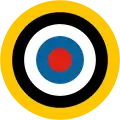 Manchuria Aviation Company roundel, 1931–1945
Manchuria Aviation Company roundel, 1931–1945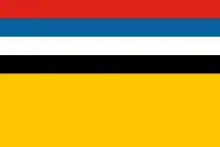 War ensign of Manchukuo, 1932–1945
War ensign of Manchukuo, 1932–1945 Manchukuo Army insignia, 1932–1945
Manchukuo Army insignia, 1932–1945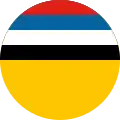 Manchukuo Air Force roundel, 1937–1945
Manchukuo Air Force roundel, 1937–1945 Central Bank of Manchou 1 yuan banknote, 1932
Central Bank of Manchou 1 yuan banknote, 1932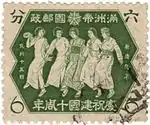 Commemorative stamp propagating the "Concord of Nationalities"
Commemorative stamp propagating the "Concord of Nationalities"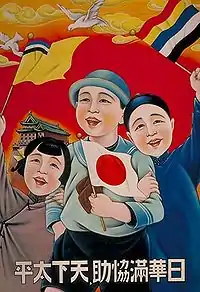 "With the cooperation of Japan, China, and Manchukuo the world can be in peace," 1935
"With the cooperation of Japan, China, and Manchukuo the world can be in peace," 1935 South Chahar Autonomous Government propaganda, c. 1937–1939
South Chahar Autonomous Government propaganda, c. 1937–1939
References
This article is issued from Wikipedia. The text is licensed under Creative Commons - Attribution - Sharealike. Additional terms may apply for the media files.